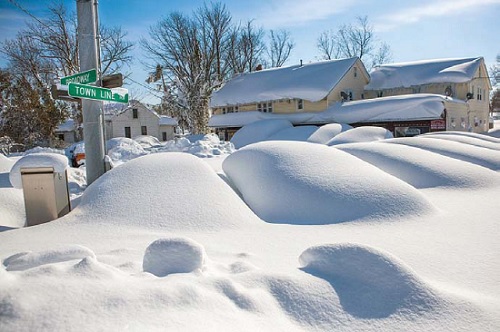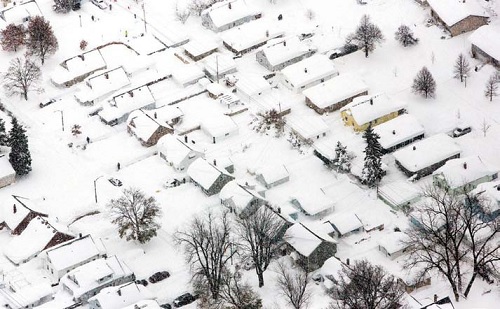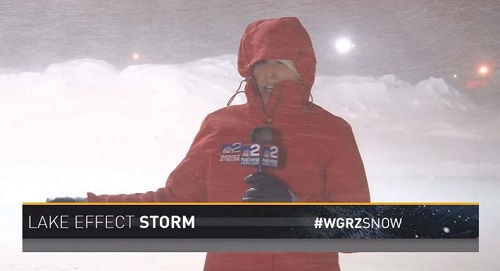Buffalo Stations Weather Record Snows

BUFFALO, N.Y.—TV news: 1, Blizzard: Zero. That’s the score in the wake of the freak November 2014 snowstorm that dumped up to seven feet of snow onto Buffalo and surrounding areas. Despite impassable roads and manpower shortages, local TV stations succeeded in delivering ’round-the-clock comprehensive coverage thanks to hard work, creative thinking, and help from their smartphone-using viewers.
NEITHER SNOW NOR RAIN...
The treacherous road conditions and high winds in the Buffalo region didn’t deter local news directors from sending their crews into the storm. At NBC affiliate WGRZ (Channel 2), this meant getting the station’s two ENG trucks on the road; supplemented by coverage from a TVUPack backpack transmitter that can send audio/video signals over cellular telephone systems. The TVU unit was useful “for getting a lot of driving shots,” said Jeff Woodard, WGRZ’s news director. It filled in the gaps when the ENG truck was in motion and not capable of sending footage back through its own transmitter mast.
CBS affiliate WIVB (Channel 4) opted to keep its ENG unit close to home, covering emergency news conferences in the relatively accessible downtown core. For coverage in snow-clogged and hard-to-reach areas, WIVB relied on mobile news crews equipped with TVUPacks. “The TVUs really saved us,” said Nancy Sanders, WIVB’s news operations manager. The units’ backpack design made it possible for WIVB’s crews to hike into areas lacking road access.
With one-third of its staff unable to reach the station due to the storm, WIVB called in ENG crews from LIN Media stations in Youngstown, Ohio (WKBN) and Hartford, Conn. (WTNH).
“We asked them to ‘please be self-sufficient’,” Sanders said. “So they came with cameras, laptops and TVUs.”
THE IMPORTANCE OF VIEWER VIDEO
Even with ENG trucks and TVUs, there were many areas that the Buffalo news crews simply could not reach, due to the many feet of snow blocking the region’s roadways. This is where the stations’ loyal viewers came to the fore; many of them stranded in the worst-hit areas yet fortuitously still connected to electricity and the Internet. These viewers shot eyewitness footage of the storm’s impact in their area. They then supplied their footage to the broadcasters via the Web or cellular telephone.

An aerial view of a snow-covered neighborhood in the town of Cheektowaga near Buffalo. “We got a lot of iPhone videos from our viewers,” said WGRZ’s Woodard. “They would email us 30-40 second clips, and then do phoners with us talking over the video. On air, it looked like regular ‘live shots’.” (Staff members who didn’t have access to camera equipment could shoot iPhone videos and send them in for broadcast.)
Get the TV Tech Newsletter
The professional video industry's #1 source for news, trends and product and tech information. Sign up below.
To maximize picture quality, smart viewers shot their videos with their phones held sideways, to create 16:9 aspect pictures. This, plus the iPhone’s HD-quality video, resulted in footage that “was very good, and better than we get on Skype,” he said.
To boost viewer morale, WGRZ asked them to shoot short ‘thank you’ videos, recognizing local neighbors who had helped them out during the storm. “I did the first one,” Woodard said. “I got stuck in snow twice trying to get to work, and people got me out!”
WIVB assigned a specific producer to solicit and manage photos/videos from viewers. Like WGRZ, these videos helped the station provide coverage from the worst affected areas, such as “inundated trailer parks and seniors’ complexes,” according to Sanders. The station also did some interviews with snowbound viewers via Skype.

WGRZ-TV included hashtags in its coverage to direct its viewers to the station’s Twitter feed. As well, one viewer sent WIVB aerial footage that they’d shot using a camera-equipped remote-controlled drone; giving WIVB an unprecedented look at the damage. (WGRZ was fortunate to receive aerial footage shot by an NBC News helicopter.)
After checking with WIVB’s legal department to verify that the drone footage could be used, the station took it to air. According to Sanders, the footage was very clear and informative; providing their audience with some stunning wide angle shots. “The drone even flew over Ralph Wilson Stadium [home of the NFL’s Buffalo Bills, who had to move their game to Detroit], to show us how the snow melt was going,” she said.
EXPANDED CAPABILITIES
The use of cellular bonded units, smartphone cameras, and Skype indicates just how much “breaking news” coverage has changed in the last 10 years. For broadcasters such as WGRZ and WIVB, this change was a godsend during the November 2014 “snowpocalypse” that buried Buffalo. Without this technology, these stations would not have been able to provide the depth of coverage that they did; not just for creating great television, but keeping their viewers safe during an unprecedented natural disaster.
“Did we depend on it? Absolutely,” said Nancy Sanders. “It all functioned very well.”
James Careless is an award-winning journalist who has written for TV Technology since the 1990s. He has covered HDTV from the days of the six competing HDTV formats that led to the 1993 Grand Alliance, and onwards through ATSC 3.0 and OTT. He also writes for Radio World, along with other publications in aerospace, defense, public safety, streaming media, plus the amusement park industry for something different.

